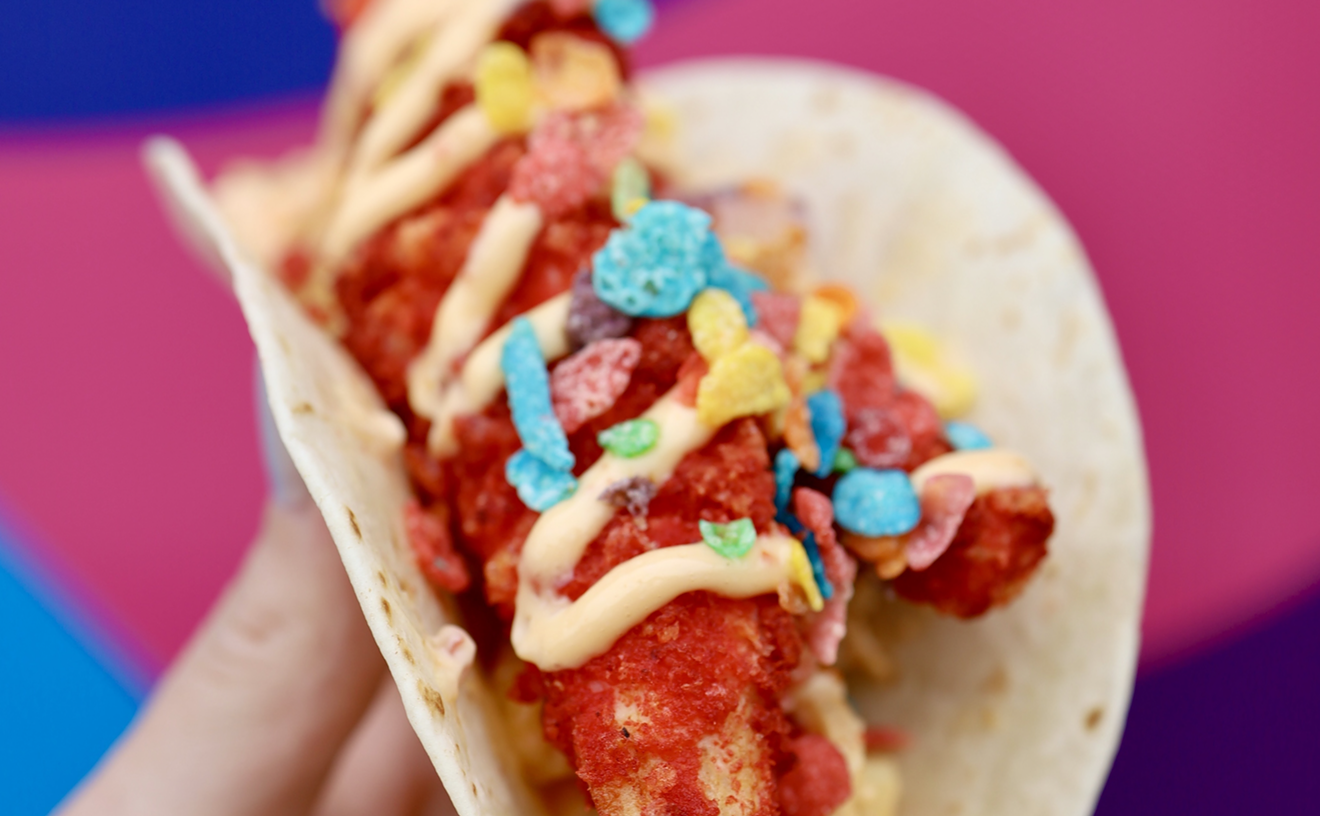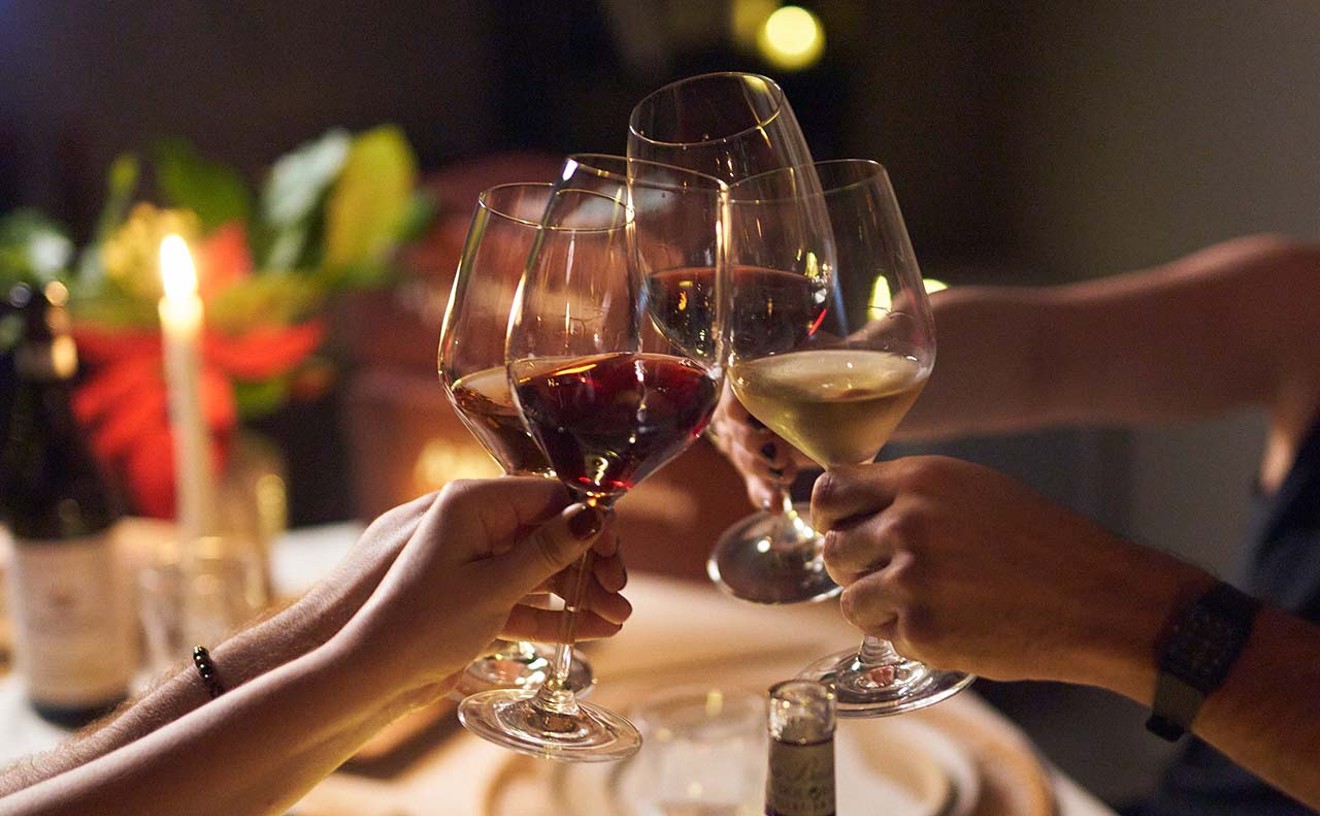If you apply this thinking to Big Fish Mayaimi, you just might find yourself dining in the theater of the absurd. Located near downtown on the south bank of the Miami River, the hard-to-find indoor/outdoor restaurant features a "tri-unicorn" sculpture -- a sheep standing on a pig, which in turn stands on a cow -- in its courtyard. (This new piece replaces a gigantic shoe that converts into a gondola when its mirrored heel is detached.) Sometimes the waitstaff can be insufficiently rehearsed, as on a recent Friday evening when four different employees asked me if I had a reservation, which was kind of beside the point when the 45 or so seats outside on the dock were empty and remained so throughout my meal. Telephone demeanor can be sweet and in Spanish or curt and in Spanish, depending on who answers. And the menus, those all-important "character references," are shaped and colored like tongues that have suffered a nuclear accident.
Primary set designer for Big Fish Mayaimi is Spanish artist Antoni Miralda, who puts the "character" in "character reference." Something of a local Christo, he arranges bizarre artistic stunts, one of which joined the Statue of Liberty and a statue of Christopher Columbus (located in Barcelona Harbor) in holy-hell matrimony. (I'd love to have been at that wedding feast: "Give us your tired, your hungry, your Indian spices....")
The big shoe and the stack of livestock are mementos of some of Miralda's other projects; he has also indulged his sense of whimsy at Big Fish Mayaimi by constructing a fence of tires. Then there's his color scheme for the place: neon pink inside, with blue and aqua exterior walls. So it should come as no shock that Miralda and his wife/co-proprietor Montse Guillen don't want you to think of Big Fish Mayaimi as merely a restaurant. Nor do they want you to pretend it's a theater. (Pay attention: This is where the tongues come in.) Miralda and Guillen envision Big Fish Mayaimi as a work of art. As Miralda explained to New Times writer Judy Cantor, the tongue represents the "landscape of Miami, which is a series of different tongues.... The tongue nourishes us and it allows us to express ourselves, to communicate with other foreign tongues." Yup, that's Miami, all right: one big tongue.
Miralda has owned two other gallery-cum-restaurants. The first was in the early Seventies with wife numero uno Dorothee Selz, whom he met in Paris and with whom he fashioned edible objets. He opened the second, El Internacional, in New York City in the early Eighties with Guillen, who had also owned a restaurant in Barcelona; they met at the latter approximately twenty years ago, and he asked her to bake 1000 loaves of bread with flutes in them. She agreed. They soon left Spain for New York, then moved to Miami in the early Nineties. Here she has cooked at the now-defunct Shabeen Cookshack, an artfully created Jamaican "dive" -- the translation of shabeen -- that like Big Fish Mayaimi was better known for its decor than its food. (Mayaimi is the Tequesta Indians' name for this area, meaning "big water." The site of the restaurant was once a burial ground.)
Tourists like Big Fish because it's one of the few spots in the city where, in addition to scanning the river for manatee and admiring the occasional great blue heron, you can truly dine right on the water. If you're able to ignore the Metrorail a few blocks to the west and the Brickell Avenue drawbridge a hundred meters to the right ... and if you're lucky enough to dine before airplanes start taking off from MIA (Big Fish is directly under the nighttime flight path) but after horn-blowing tugboats have finished for the day ... and if passengers on the dinghy Praise the Lord! don't toss fish guts to a flock of squealing seagulls and pigeons (and above them, turkey vultures; Miralda should sculpt this scene for his courtyard), then you just might enjoy a really peaceful meal on the narrow dock under a corrugated metal overhang. (Approximately 50 people can be accommodated at indoor tables.)
In 1986 the property was converted from a gas station to Big Fish Restaurant by local character Thomas Orren "T.O." Sykes, who painted his appliances purple or turquoise or some such color, and who named at least one of his tables after Connie Chung and another after a neighbor's dog, Casey. He sold the place to one of the restaurant's waiters in 1992, but after Sykes's death in 1995, legal snafus returned it to its original landlord, Marge Brickell.
But while history and eccentricities distinguish Big Fish, its food has met with indifference, or outright dislike, since 1996, when Miralda and Guillen convinced Brickell to let them renovate the place and rename it Big Fish Mayaimi. I've heard lots of complaints from friends about Sykes's famous grouper sandwich being replaced by a gaping pita pocket stuffed with chunks of pan-fried mahi-mahi, pickled red onions, and chopped romaine (potato sticks garnish the lunch item). I confess to enjoying the pita fish sandwich, despite its tendency to disintegrate, but I also have found the fare in general to be, well, less than scintillating.
Guillen has made some changes in the kitchen. In November she hired Miguel Marrero, a Puerto Rican chef with a multicultural past: lived in Hawaii, owned a restaurant in Germany, and worked at Mark's Las Olas in Fort Lauderdale. My first meal under his direction left me relatively unwowed. Mediterranean fish soup was attractively presented, with tiny clams in the shell, chunks of snapper and grouper, and chopped leeks, but the soup itself was so salty we sent it back virtually untouched.
We had the same problem with a grilled wahoo fillet, a special entree that evening. From the waiter's description we expected the fish to be topped with lump crabmeat; instead, the generous and flaky fillet was sauced with a briny crabmeat reduction. Simple grilled snapper, dressed with a squeeze of lime, fared much better. Likewise, a lunchtime dish of grilled whole baby squid, tender and succulent, was delicious, so I'd recommend sticking with uncomplicated items. Dinners were accompanied by a good rice pilaf, livened up with kalamata olives.
The proprietors' Spanish connection is evident on both the regular menu and the specials blackboard posted at the entrance to the outside eating area. We ordered an interesting escabeche appetizer from the latter, the marinated swordfish steak arriving breaded and fried. The swordfish was tasty, served at room temperature over a bed of frilly greens and topped with pickled onions. Ceviche, which given the size of the portion can be ordered as an appetizer or a main course, was at once mild and flavorful with onions and oregano. But some of the marinated fish chunks were tough.
We passed over fried squid in favor of fried smelts (not always available here); these tiny little fish, which you eat whole, were battered and deep-fried. But the oil they were cooked in seemed old, so the smelts were somewhat stale-tasting. Fried mozzarella and tomato salad was an improvement oil-wise; here the coating on the melted cheese slabs was a light and crisp golden-brown. Our only complaint was that the honey-mustard dressing that moistened the dish was too sweet, failing to harmonize with the mozzarella.
Big Fish Mayaimi is known for its paella: seafood, seafood and chicken, and wild mushroom. We watched as customers docked their yacht just for the privilege of eating some. Officially, the restaurant will serve the rice dish only to a minimum of four persons, but the staff was agreeable enough to make an exception for us one evening and prepare it for two. (An option for parties of less than four is black rice with squid and baby octopus.) Served in a large, shallow pan, the wild mushroom paella was enough to feed a half-dozen people. While the rice was evenly cooked, the woodsy mushrooms were overdone and slimy; and with its numerous sprigs of rosemary, the entire dish was just a bit too aromatic.
The restaurant could develop a well-deserved reputation for its churrasco, the menu's only beef entree. (Rosemary-garlic chicken is the sole poultry item.) The marinated and grilled skirt steak was one of the best I've had in awhile: juicy and supple.
Dessert, limited to three choices (and even these aren't always available), was the finest part of our first meal. We tried brazo gitano, a light sponge cake rolled with creamy, sticky dulce de leche. The short wine list is also a delight, yielding some good Spanish bottles for less than twenty dollars. And I should add that the overall fare has improved exponentially with each successive visit I've made, though waiters continue to remove wineglasses that aren't empty when they bring a new round. I feel more confident now than I did in the past, that Big Fish's food might someday become a draw in itself.
Big Fish Mayaimi
55 SW Miami Avenue Rd, Miami; 305-373-1770. Lunch and dinner daily from 11:30 a.m. till 11:30 p.m.
Mediterranean fish soup $6.00
Grilled squid $9.00
Churrasco $16.00
Wild mushroom paella (per person) $18.00
Brazo gitano $4.
00










